From the Manual Of
Tropical And Subtropical Fruits
by Wilson Popenoe
Historical
Information about the Avocado Races and Varieties
To use the
definition of H. J. Webber, 1 "Races are groups of cultivated plants
that have well-marked differentiating characters, and propagate true to
seed except for simple fluctuating variations." Technically speaking,
the Mexican avocados should not be called a race, since they really
represent a species; the West Indian and the
Guatemalan, however, do not appear to differ from each other except in
minor characters.
The classification of avocados into these three
races has been useful, inasmuch as it brings together all those
varieties which have several characteristics in common. In fact, the
mere statement that an avocado belongs to the West Indian, Guatemalan,
or Mexican
race gives one an idea of the relative hardiness, season of
ripening, and commercial character of the fruit. The botanical standing
of the cultivated races, as at present understood, and the characters
which serve to distinguish them horticulturally, are shown in the
following key in the Standard Cyclopedia of Horticulture.
1. Leaves anise-scented; skin of fruit thin
(rarely more than 1/32 inch in thickness) Persea drymifolia Mexican
Race of horticulture
2. Leaves not anise-scented; skin of fruit thicker
(from 1/32 to 1/4 inch in thickness) Persea americana
a. Fruit summer and fall ripening; skin usually not more than 1/16 inch
thick, leathery in texture. West Indian Race b. Fruit winter and spring
ripening; skin 1/16 to 1/4 inch thick, woody in texture. Guatemalan Race
One variety cultivated in the United States, the
Fuerte, appears to be a hybrid between the Mexican and Guatemalan
races. Others of similar origin are likely to appear at any time, hence
it is desirable to establish a group to include hybrids.
The avocados of the West Indian race have been
developed in the tropical lowlands; the Guatemalan race, on the
other hand, is a product of the highlands. At intermediate elevations
varieties appear which belong to neither of these races, but possess
some of the characters of each. These intermediate forms cannot be
classified with accuracy.
In selecting varieties for commercial planting, it
must be
borne in mind, first of all, that the tree must be vigorous and hardy
enough to grow successfully in the particular location which the
planter has in view. Secondly, it must in time produce sufficiently
large crops of marketable fruit to make its culture commercially
profitable. It is not necessary that it be very precocious; it is
noticeable, in fact, that precocious varieties often fail to make
vigorous trees. It is more desirable to have the tree devote itself
during the first three years to the development of an extensive
root-system and a well-branched crown capable of withstanding the drain
imposed by the production of heavy crops of fruit than to have its
growth limited and its vitality exhausted by premature fruiting.
Thirdly, the fruit itself must be given consideration from a commercial
standpoint. Attractiveness, flavor, shipping qualities, season, and
other important characteristics should be considered in respect to the
market it is proposed to supply. Naturally, good shipping quality can
be sacrificed to some other point if the fruit is for local use, while
it is essential if the fruit is destined for distant markets. The
flavor and quality of the flesh should be as good as possible, and the
seed should not be unduly large.
More than one hundred and fifty varieties have
been propagated in the United States up to the present time. The larger
part of these originated as seedlings in California and Florida; the
remainder have been introduced from Mexico, Guatemala, Cuba, the
Bahamas, Hawaii, and a few other regions.
Of this large number not more than a dozen are
likely to be planted ten years hence. Indeed, most of them have already
been discarded. New varieties are originating every year, however, and
the introduction of promising sorts from foreign countries is receiving
much attention. It is only by testing a large number of varieties from
all of the important avocado regions of the tropics that the best
available kinds for commercial cultivation can be obtained.
It is not desirable to burden such a work as this
with descriptions of all the avocados which have been propagated. It is
sufficient to include the more important ones which are at the present
time being planted commercially. For descriptions of minor varieties,
and for information regarding the behavior and value of new
introductions, the reader is referred to the annual reports of the
California Avocado Association. In 1917 this organization issued
Circular No. 1, "Avocado Varieties Recommended for Planting in
California," the suggestions contained in which have done much to
eliminate from consideration numerous inferior sorts. The varieties
recommended in this circular are as follows, the arrangement being
according to season of ripening in California:
Spring
varieties
Fuerte, Spinks, Blakeman, and Lyon
Summer
varieties
Spinks, Blakeman, Lyon, Dickinson, and Taft
Fall varieties
Taft, Dickinson, and Sharpless
Winter
varieties
Sharpless, Puebla, and Fuerte
Several of these varieties may be superseded within a short time by
others which are now being tested in California. It is not to be
expected that the industry can settle down to the cultivation of a few
standard sorts until all of the promising ones have been tested, and
this may require several years.
In Florida, the only variety which was extensively
planted during the first fifteen years of the industry was Trapp. With
the introduction of the Guatemalans, however, the question has become
more complicated, and it will take some time to determine by actual
trial which members of this race are most suitable for cultivation in
different parts of the state.
It is probable
that varieties will be obtained which will make it possible, both in
California and Florida, to market avocados in every month of the year.
Indeed, it is almost possible to do so at the present time. In other
regions horticulturists should work toward this end by obtaining for
trial varieties ripening at different seasons.
Mexican
Race
This race, which embraces the hardiest avocados
cultivated in the United States, is particularly valuable for regions
too cold for the West Indian and Guatemalan varieties. It is
extensively cultivated in the highlands of central and northern Mexico,
whence seeds have been brought to California, resulting in numerous
seedling trees scattered throughout the southern half of the state. In
Florida it has never become popular, but good varieties have not been
introduced until recently. Some of them promise to prove of value for
the colder sections of that state.
From its native home in Mexico this race has spread to several other
regions, most notably Chile, where it appears to be well known. It is
the only race grown successfully in the Mediterranean region, trees
having fruited at Algiers, in southern Spain, along the Riviera in
southern France, and even in such a cold location as that of Rome. In
tropical regions outside of Mexico it seems to be little cultivated.
The anise-like scent of the foliage and immature fruits is the most
distinctive characteristic of the race and the one by which it is
usually identified. The leaves are commonly smaller than those of the
Guatemalan and West
Indian races, and sharper at the apex. The fruit is small, 3
to 12 ounces in weight, rarely 15 or 16 ounces. The skin is thin, often
no thicker than that of an apple, and usually smooth and glossy on the
surface. The color varies from green to deep purple. The seed is
commonly larger in proportion to the size of the fruit than in the Guatemalan race.
The seed-coats are both thin, sometimes closely united and adhering to
the cotyledons, sometimes separating as in the West Indian race. The
flowers are heavily pubescent, and appear in winter or early spring,
sometimes as early as November and usually not later than March. The
fruit ripens in summer and autumn, commencing in June in Florida and
August in California. Sometimes a second crop is produced from late
flowers, ripening from March to May in California.
Northrop - Form obovate to pyri-form, sometimes distinctly necked; size
small, weight 5 to 8 ounces, length 4 inches, greatest breadth 2 1/2
inches; base narrow, the slender stem inserted squarely almost without
depression; apex rounded; surface smooth, very glossy, deep purple in
color, with a few small maroon dots; skin thin, adhering closely to the
flesh, membranous; flesh buttery, cream yellow in color, practically
free from fiber, and of rich flavor; quality good; seed oblong-conic,
small, fitting tightly in the cavity with the seed-coats both adhering
closely. Season October and November at Santa Ana, California, with a
second crop maturing in April and May.
Originated near Santa Ana, California; first propagated in 1911 under
the name Eells. The tree is vigorous, frost-resistant, and productive.
Puebla - Form obovoid, slightly oblique; size below medium to medium,
weight 8 to 10 ounces, length 3 1/2 inches, greatest breadth 2 7/8
inches; base obliquely flattened, the stem inserted slightly to one
side in a small shallow cavity; apex obliquely flattened but not
prominently so; surface smooth, glossy, deep maroon-purple in color,
with numerous reddish dots; skin less than 1/32 inch thick, easily
peeled from the flesh, firm in texture; flesh rich cream yellow near
the seed, changing to pale green near the skin, buttery in texture, and
of rich nutty flavor; quality very good; seed medium to large, tight in
the cavity, with both seed-coats adhering closely to the cotyledons.
Season December to February in southern California.
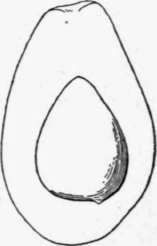
Fig. 8. The Northrop avocado. (X3/7)
Originated at Atlixco, state of Puebla, Mexico; first propagated in
1911, in which year it was introduced into California. A vigorous and
hardy variety, fruiting later in the season than most others of its race
West
Indian Race
This race is the predominant one in the West Indies and throughout the
low-lying portions of the tropical American mainland. It is found as
far north as Florida and the Bahama Islands, and as far south as
central Brazil. From its home in America it has been carried to
Madeira, the Canary Islands, parts of tropical Africa, Oceania, and the
Indo-Malayan Archipelago. It is much more widely disseminated than
either of the other races. The name South American race is sometimes
applied to it, while P. H. Rolfs termed it the West Indian-South
American.
Practically all of the avocados cultivated in Florida previous to the
introduction of the Guatemalan
were of this race. In California it has never been extensively grown;
only a few trees, in fact, are known to have fruited in that state. It
is the most susceptible to frost of the three races, and is best suited
to cultivation at low elevations in the tropics.
The foliage of the West Indian race lacks the anise-like scent which
characterizes the Mexican;
in general, it resembles the foliage of the Guatemalan closely, but
often the young branchlets and the leaves are lighter in color. The
fruits are produced on short stems; the smallest weigh 4 or 5 ounces,
the largest 3 pounds or more. The surface is nearly always smooth,
yellow-green to maroon in color, the skin rarely more than 1/16 inch
thick, pliable and leathery in texture. The seed is usually large in
proportion to the size of the fruit, and often loose in the seed
cavity. The cotyledons are often rough on the surface, with the two
seed-coats frequently thick and separated, at least over the pointed
end of the seed, one of the coats sometimes adhering to the cotyledons
and the other to the wall of the seed cavity. The flowers are characterized by less
pubescence than those of the Mexican race, but are very similar to
those of the Guatemalan; sometimes they are almost devoid of
pubescence. The flowering season is from February to March in Florida,
the fruit maturing from July to November, in certain varieties
sometimes remaining on the tree until December or January.
Pollock (Fig. 4). - Form obovate to oblong-pyriform; size very large to
extremely large, weight commonly 25 to 35 ounces, but occasionally
attaining to 50 ounces, length 6 1/2 to 7 1/2 inches, greatest breadth
4 to 5 inches; base narrow, flattened slightly, with the short stem
inserted obliquely in a shallow, flaring, regular cavity; apex
obliquely flattened or slightly depressed; surface smooth, light
yellowish green in color, with numerous small greenish yellow or russet
dots; skin less than 1/16 inch thick, separating very readily from the
flesh, tough and leathery; flesh firm, smooth and fine in texture, deep
yellow changing to yellowish green close to the skin, almost without a
trace of fiber discoloration; flavor rich, rather dry, very pleasant;
quality excellent; seed conic, oblique at base, rather small, weighing
about 4 ounces, usually fitting snugly in the cavity but sometimes
loose, the seed-coats rather loose, more or less separate; season
August and September at Miami, Florida. Originated at Miami, Florida;
first propagated in 1901. It has been planted more extensively than any
other West Indian variety except Trapp. It is remarkable for its large
size and excellent quality.
Trapp (Fig. 5). - Form roundish oblate, obliquely flattened at the
apex; size large to very large, weight 16 to 24 ounces, length 4 to 4
1/2 inches, greatest breadth 4 1/4 to 4 3/4 inches; base narrowing
slightly, flattened around the deep, narrow, rounded, regular cavity in
which the short stem is inserted; apex obliquely flattened; surface
smooth to undulating or slightly pitted, pale yellow-green in color,
with numerous small to medium sized, irregular, pale greenish yellow
dots; skin 1/16 inch thick, separating very readily from the flesh,
firm, leathery and pliable; flesh firm, very smooth, rich cream-yellow,
changing to pale green near the skin, fiber discoloration very slight;
flavor moderately rich, pleasant, quality good; seed broadly oblate,
large, about 5 ounces in weight, nearly tight in the cavity, with the
seed-coats adhering more or less closely to the cotyledons or sometimes
to the lining of the cavity. Season commencing in late September or
October at Miami, Florida, and extending until the end of December,
with a few fruits hanging on until the end of February or March.
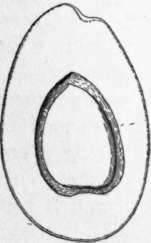
Fig. 4. The Pollock avocado.
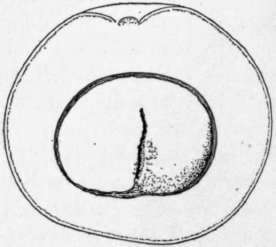
Fig. 5. The Trapp avocado.
Originated at Coconut Grove, Florida; first propagated in 1901. An
unusually late variety, and for this reason valuable. It was the only
avocado planted extensively in Florida previous to the introduction of
the Guatemalans. The tree is very productive, but is a weak grower and
susceptible to frost.
Waldin. - Form oblong to oblong-pyriform; size large to very large,
weight 18 to 28 ounces, length 5 to 6 1/2 inches, greatest breadth 3
3/4 to 4 1/2 inches; base somewhat narrowed with the rather short thick
stem inserted squarely; apex slightly flattened; surface smooth,
usually without markings; skin 1/16 inch thick, separating readily from
the flesh, tough and leathery in texture; flesh firm, deep yellow in
color, smooth, with very little trace of fiber; flavor rich and
pleasant ; quality excellent; seed obovate, rather large, weighing
about 5 ounces, usually tight in the cavity. Season October until early
January at Homestead, Florida.
Originated near
Homestead, Florida; first propagated in 1915. The tree is a strong
grower, productive, and more resistant to cold and to fungous diseases
than the average variety of its race. Valuable on account of its
lateness in ripening, and the good quality of its fruits.
Guatemala
Race
Although planted in California as early as 1885,
the Guatemalan race did not begin to attract attention until about
1910. With the increase of interest in avocado culture which had its
inception in California about that time, a number of fruiting trees
were brought to light, most of them grown from seed introduced about
1900 by John Murrieta of Los Angeles, although the first tree was
planted by Jacob Miller at Hollywood. Because of the excellent
commercial qualities of the fruits produced by these seedlings and the
season at which they ripened, several of them were propagated and named
as horticultural varieties. The number has now increased, both through
the fruiting of seedlings locally and the introduction of selected
varieties from southern Mexico and Guatemala, especially from the
vicinity of Atlixco, Puebla, Mexico, which was the source of most of
the seeds introduced by Murrieta and has since furnished budwood of
many choice varieties.
In Florida this race came into notice even later
than in California. Several trees grown from seeds sent from Guatemala
by G. N. Collins about 1901 came into bearing at the Miami Plant
Introduction Garden in 1911-1912, and their season of ripening,
February to April, immediately stimulated interest in this race, since
a winter-ripening avocado had been the greatest desideratum of Florida
growers. Budwood of practically all the varieties growing in California
was obtained, and the first offspring of these came into bearing at
Miami in 1915. While it can thus be seen that the Guatemalan race is
new to Florida, it promises to become of great commercial value, and it
has the decided advantage that its culture will be possible farther
north than that of the West Indian race. Up to
the present the trees are successful under Florida conditions. The
varieties that have so far fruited ripen from October to May.
In other countries the distribution of this race
is limited. It was introduced into Hawaii in 1885, and has recently
begun to attract attention in that territory. Lately it has been
planted in Cuba, where it promises to be successful. It has also been
introduced into Porto Rico and a few other regions, but only within the
last few years.
The foliage of the Guatemalan race, as of the West
Indian, lacks the anise-like odor which characterizes the Mexican. It
is commonly deeper colored than the West Indian, the new growth often
being deep bronze-red. The fruits, weighing 4 ounces to more than 3
pounds (commonly 12 to 20 ounces), and borne on long stems, are light
green to purplish black in color. The surface is often rough or warty,
especially toward the stem end of the fruit. The skin is usually over
1/16 inch, sometimes 1/4 inch, thick. This characteristic, together
with the texture of the surface, is variable, occasional forms being
found which have the skin scarcely thicker or rougher than in the West
Indian race. It is usually harder, however, and more coarsely granular
in character. The seed completely fills the cavity. The cotyledons are
nearly or quite smooth, the seed-coats thin, closely united, and
adherent to the cotyledons throughout. The flowers, more finely
pubescent than in the Mexican race, are similar in character to those
of the West Indian. They appear much later than those of the Mexican
race, usually beginning to open in late spring, about the time those of
the West Indian race (in Florida) are setting fruits. Unlike both the
other races, the fruit does not ripen in the ensuing summer, but is
carried over into the following autumn, winter, or spring; while in
California, fruits which develop from flowers appearing in June may
remain on the tree until a year from the following October. The
ripening season in general is winter and spring in Florida, somewhat
later in California, where the earliest varieties at present cultivated
begin to ripen late in January or in February, and the latest ones hang
on the tree until October.
Blakeman. - Form broad pyriform to obconic,
oblique, broad at the basal end; size above medium to very large,
weight 14 to 20 ounces, length 4 to 4f inches, greatest breadth 3 1/4
to 3 3/4 inches; base rounded, the long stem inserted obliquely in a
very shallow cavity; apex broadly rounded, obliquely flattened or
slightly depressed on one side, with the stigmatic point raised;
surface slightly undulating to roughened, but not so rough as in many
other Guatemalan varieties, dark green with numerous large yellowish or
reddish brown dots; skin thick and woody, separating readily from the
flesh, brittle, granular; flesh fine-grained, firm, deep cream-yellow
in color, tinged with green near the skin, free from fiber or
discoloration; flavor rich, pleasant; quality very good; seed broadly
conic, medium sized, fitting tightly in the cavity with both seed-coats
adhering closely. Season April to August at Hollywood, California.
Originated at Hollywood, California; first
propagated in 1912, under the provisional names Habersham and Dickey
No. 2.
Dickinson (Fig. 6). - Form oval to obovate,
sometimes almost pyriform; size small to medium, weight 9 to 14 ounces,
length 3 1/2 inches, greatest breadth 2 3/4 inches; base not noticeably
flattened, the long stem inserted in a very small and shallow cavity;
apex rounded; surface very rough, verrucose or tuberculate around the
base, dark purple in color with large, irregular, maroon dots; skin
very thick, especially near the base, separating fairly readily from
the flesh, coarsely granular, woody, brittle; flesh buttery, pale
greenish yellow, free from fiber, of pleasant flavor; quality good;
seed roundish oblate, medium sized, tight in the cavity, with both
seed-coats adhering closely. Season June to October at Los Angeles,
California.
Originated at Los Angeles, California; first
propagated in 1912. Vigorous in growth and precocious in fruiting.
Lyon.
- Form broad pyriform, indistinctly necked, and sometimes oblique at
the apex; size above medium to large, weight 14 to 18 ounces, length
about 5 1/2 inches, greatest breadth 3 1/2 inches ; base narrow, the
long stout stem inserted obliquely almost without depression; surface
undulating to rough, bright green in color, with numerous small
yellowish or russet dots; skin moderately thick, separating very
readily from the flesh, coarsely granular, brittle; flesh smooth, firm,
deep cream colored, tinged with green toward the skin, free from fiber
discoloration, the flavor very rich and pleasant; quality very good;
seed broad conic, medium small to medium in size, fitting tightly in
the cavity with both seed-coats adhering closely. Season April to
August at Hollywood, California. Originated at Hollywood, California;
first propagated in 1911. The tree is precocious in bearing, and the
fruit is of excellent quality.
Sharpless.
- Form slender pyriform to elongated pyriform with a long neck; size
large to very large, weight 16 to 24 ounces, length 6 to 6 1/2 inches,
greatest breadth 3 1/4 inches; base very narrow, the long stem inserted
obliquely without depression; apex rounded; surface slightly roughened
or pitted, glossy, greenish purple to deep purple in color, with
numerous yellowish dots; skin thick, separating readily from the flesh,
granular and woody; flesh smooth, firm, cream colored, free from fiber
discoloration, and of unusually rich pleasant flavor; quality
excellent; seed oblate-oblique, small, weighing 1 1/4 ounces, fitting
tightly in the cavity, with both seed-coats adhering closely. Season
October to February at Santa Ana, California.
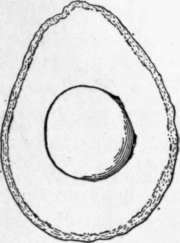
Fig. 6. The
Dickinson avocado. (X 3/8)
Originated near Santa Ana, California; first
propagated in 1913. This is a fruit of fine quality, ripening very late
in season.
Solano. - Form broadly obovate to oval; size above
medium to large, weight 16 to 24 ounces, sometimes attaining to 28
ounces, length 5 3/4 inches, greatest breadth 3 7/8 inches; base
rounded, with the long stem inserted obliquely without depression; apex
oblique, slightly flattened; surface nearly smooth, somewhat glossy,
bright green in color with numerous greenish yellow dots; skin
moderately thick, separating readily from the flesh, granular; flesh
firm, smooth, yellowish cream color, greenish near the skin, free from
fiber discolorations and of mild pleasant flavor; quality fair; seed
broadly conical to broadly ovate, small, fitting tightly in the cavity,
with both seed-coats adhering closely. Season March to May at Los
Angeles, California; October to November 15 at Miami, Florida.
Originated at Hollywood, California; first
propagated in 1912. Productive, and a strong grower.
Spinks. - Form broadly obovate, or ob-conic; size
extremely large, weighing from 18 to 34 ounces, length about 5 inches,
greatest breadth about 4 1/2 inches; base narrow, rounded, with the
rather short stout stem inserted almost squarely without depression;
apex rounded; surface roughened, warty around the base, dark purple in
color; skin thick, separating readily from the flesh, woody, granular,
brittle; flesh firm, smooth, rich yellow in color, free from fiber, and
of rich pleasant flavor; quality very good; seed nearly spherical,
small, weighing 3 ounces, fitting tightly in the cavity with the
seed-coats adhering closely. Season April to August at Duarte,
California.
Originated at Duarte, California; first propagated
in 1915. The tree is vigorous and productive, and the fruit of
excellent quality.
Taft (Fig. 7). - Form broad pyriform, slightly
necked; size above medium to very large, weight 14 to 24 ounces, length
5 to 5½ inches, greatest breadth 3¾ inches; base
tapering, the long stem inserted obliquely without depression; apex
rounded, with the stigmatic point raised; surface undulating to
roughened around the base, deep green in color, with numerous yellowish
dots; skin thick, separating very readily from the flesh, granular,
rather pliable; flesh firm, smooth, light yellow in color with no trace
of fiber discoloration; flavor unusually rich and pleasant; quality
excellent; seed broadly conical, medium sized, fitting tightly in the
cavity with both seed-coats adhering closely. Season May to October in
southern California.
Originated at Orange, California; first propagated
in 1912. The tree is a strong grower but has not proved very
frost-resistant in Florida. Its bearing habits have not been
satisfactory in California, but in Florida they promise to be better.
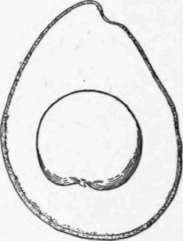
Fig. 7. The Taft avocado. (X 1/3)
Taylor. - Form pyriform to obovate; size medium to
large, weight 12 to 18 ounces, length 4 to 4 1/2 inches, greatest
breadth 3 1/2 inches; base tapering, usually not distinctly necked, the
long stem inserted obliquely almost without depression; apex rounded;
surface undulating to rough, dull green in color, with numerous small
yellowish dots; skin 1/16 inch thick, separating readily from the
flesh, granular and woody; flesh firm, smooth, yellowish cream color,
pale green near the skin, free from fiber, and of fairly rich pleasant
flavor; quality very good; seed conical, medium sized, tight in the
cavity with both seed-coats adhering closely. Season January 15 to
April 1, at Miami, Florida.
Originated at Miami, Florida; first propagated in
1914. This variety has been planted only in Florida, where it has
proved to be vigorous and reasonably productive.
|
|